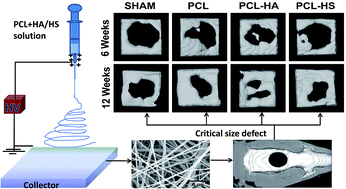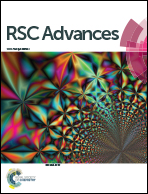Comparative bone regeneration study of hardystonite and hydroxyapatite as filler in critical-sized defect of rat calvaria†
Abstract
There is a very significant and well-known clinical need for the development of new osteoinductive materials and the establishment of alternative therapies for the treatment of bone tissue loss or failure resulting from injury or disease as the transplantation of tissues in patients with these injury or disease is severely limited by donor scarcity and is highly associated to the risk of immune rejection and disease transfer. Herein, we studied in vivo bone response by quantifying efficacy and safety of three scaffold variations: (1) nanofibrous polycaprolactone (PCL), (2) PCL–hydroxyapatite (HA), and (3) PCL–hardystonite (HS) against SHAM as the control. Diffraction pattern from TEM showed that native HA and HS were polycrystalline and they leached higher ppm of calcium, phosphorus and zinc as compared to PCL–HA and PCL–HS in which HA, HS were incorporated in PCL nanofibers. The study was performed on 8 mm critical-sized rat calvarial defects analyzed at two timepoints, 6 and 12 weeks. The bone regenerated by PCL–HS promoted higher growth than that by SHAM and PCL alone at 12 weeks with comparable bone mineral density in all groups at both time points. PCL–HS showed potential for bone growth similar to that for PCL–HA. Histology data showed dense bone interface being formed at the site in both the PCL–HS and PCL–HA groups. Therefore, HS was found to have comparable functionality with commercial HA. No significant differences were noted in any of the blood parameters but there were differences in serum biochemistry parameters of triglyceride and creatine levels among groups, which are indirectly related to bone forming potential and directly to safety of kidney function, while the other parameters were unchanged and within the normal range. Thus, we conclude that the HS material can be a suitable substitute for bone tissue engineering.



 Please wait while we load your content...
Please wait while we load your content...